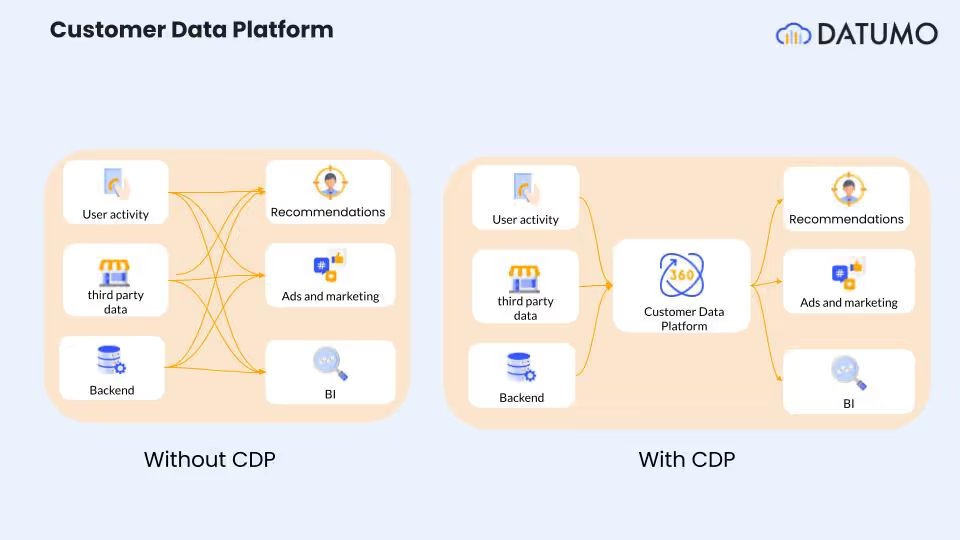What is Customer Data Platform (CDP)?
Nowadays companies strive to gain insights into the needs of their customers providing them with products and services specifically tailored to their needs and delivered on time.
To achieve this, many companies collect client information and then use tools for marketing automation, Customer Relationship Management (CRM), content management or push notifications to bring more personalized customer experiences.
This gradually leads to a situation where customer information is stored in more and more locations, with each of them containing some customer data.
One approach to this problem is to create a Customer Data Platform i.e. a centralised location within the organization where all customer data is stored. However, effectively combining data from multiple sources and customer data management can present a significant challenge.
How does a Customer Data Platform work?
While mobile applications currently dominate communication channels between the company and the customer it is crucial to draw information from multiple sources, such as websites, company backend systems and IoT devices. The key feature of sales applications is the ability to seamlessly connect various information on user activity, including financial transactions made using loyalty cards, information from Customer Relationship Management (CRM) and customer service records or other third-party data. The unified customer data from all these sources creates the Customer Data Platform (CDP).
Real time processing of all this information, utilising many sources of real-time customer data and filling in the blanks or enriching it with additional information, requires the Customer Data Platform (CDP) system to be efficient and reliable. The reliable handling of a vast amount of customer interactions per second, along with the guarantee of minimising delays, is another challenge that the CDP platform must meet.
On the other hand, efficiency of CDP software must be balanced with cost effectiveness. Automatic scaling and allocation of resources for traffic processing also present their own challenges.
Data collection and storage is only one function of the CDP platform. Other functions include Customer data integration with marketing automation solutions, data distribution to recommendation engines, the use of artificial intelligence to create personalized content, and offer customer profiles segmentation. To operate effectively, each of these external modules have their own requirements regarding the structure and amount of information transmitted which makes data unification very difficult to maintain.
CDP platforms are designed for seamless data integration and sharing of real-time data.

Customer Data Platform solutions
There are two types of solutions in the CDP market: traditional CDP and composed CDP.
Traditional CDP solutions allow you to partly consolidate real-time data in one place, manage customer data and connect to external systems and third-party data. As the old saying goes, “you pay for what you get”. Many of these quick solutions are far from perfect, despite a shorter implementation period. Their main limitations are a lack of customization options to specifically tailor functionality to client requirements. If you need to integrate data from your custom system, this will probably not be possible. Furthermore, there is an additional cost for licences often paid monthly and gradually increasing with the growth of the user base and the volume of data collection or number of data sources. Another concern for users is the storage location. Due to the fact that all information is located offsite, data control and security or data governance may be limited
What distinguishes Composable CDP from boxed CDP tools is full control over events throughout the entire customer journey. You can build your platform exactly as you need it, arranging it from blocks or even combining solutions created from scratch with ready-made modules (e.g. integration with marketing or advertising tools). We have full access to all real-time customer data which is exclusively owned and regulated by the organization in accordance with company Data privacy regulations or data management standards. No data is released externally without our knowledge and the event life cycle is closely controlled.
What is the Customer Data Platform made of?
To put it simply, CDP consists of three basic elements:
- A collector/integrator that receives real-time customer data from all sources
- A data processor and data warehouse that are responsible for appropriate transformations, aggregations, data storage and Customer data management
- an data activation layer responsible for reporting, share customer data, customer analytics, segmentation, automation and client interaction
All information is saved in real time to a data lake within the organization. No external components are involved in the processing and the data itself never goes outside the organization without our knowledge. The use of modern data lake solutions makes it possible to store both First-party data in its original form as well as aggregates, while ensuring a high level of visibility, data lineage and unify customer profiles.
What problems can Customer Data Platform (CDP) solve?
Aggregation of data from many sources creates a more accurate picture of the client and their needs, referred to as “profile 360” or “customer 360” (also known as a single customer view (SCV). The ability to combine many levels into one coherent customer image is the main advantage of the CDP platform.
More accurate information and Real-time customer interactions allows you to increase customer engagement by using marketing automation or more precise division into recipient groups and offering them even better tailored services and content positively impacting customer experience.
Avoiding data silos and increasing the possibilities offered by real-time data collection to improve the use of data insights. Data Democratization combined with the ability to track customer behavior in real time enables the creation of customer journey orchestration tools.
Benefits of Customer Data Platform (CDP)
Customer data management
Implementing a CDP can help you create a faster, more accessible single customer view (SCV). Combining multiple data sources into a central data warehouse allows you to create a more accurate unified customer profile. More customer interaction data can positively impact: Accurate segmentation, more customer insights, and improved customer journey through more tailored marketing campaigns. Flexibility in platform development and Customer data integration with future services while maintaining a single customer view (SCV). Connecting multiple data sources and building a modern data warehouse based on data lake architecture. Simplifying data governance while taking care of sensitive customer data.
Personalization
For the customer, using CDP allows for the application of personalized customer experiences through the use of more tailored content. Increasing customer engagement and improving the appearance of the brand by creating an image of a modern and putting the requirements of its Customer experience (CX) first. This can have a positive impact on customer loyalty and create completely new development opportunities.
Summary
In modern business, real-time customer data plays a key role in digital transformation and organization. An effective Customer Data Platform requires scalable data processing solutions and modern data warehouse allowing you to integrate data from any sources to create a single customer view. In a world where business interaction increasingly takes place online, inevitably leaving a data footprint, , it is worth utilizing Customer Data Platforms to ensure better security and allow businesses to grow.
If you want to build or understand Customer Data Platform, we encourage you to contact our experts who are responsible for the creation of the 3rd largest CDP in Poland which can process more than 20k customer interactions per second.



.png)

.avif)

.avif)